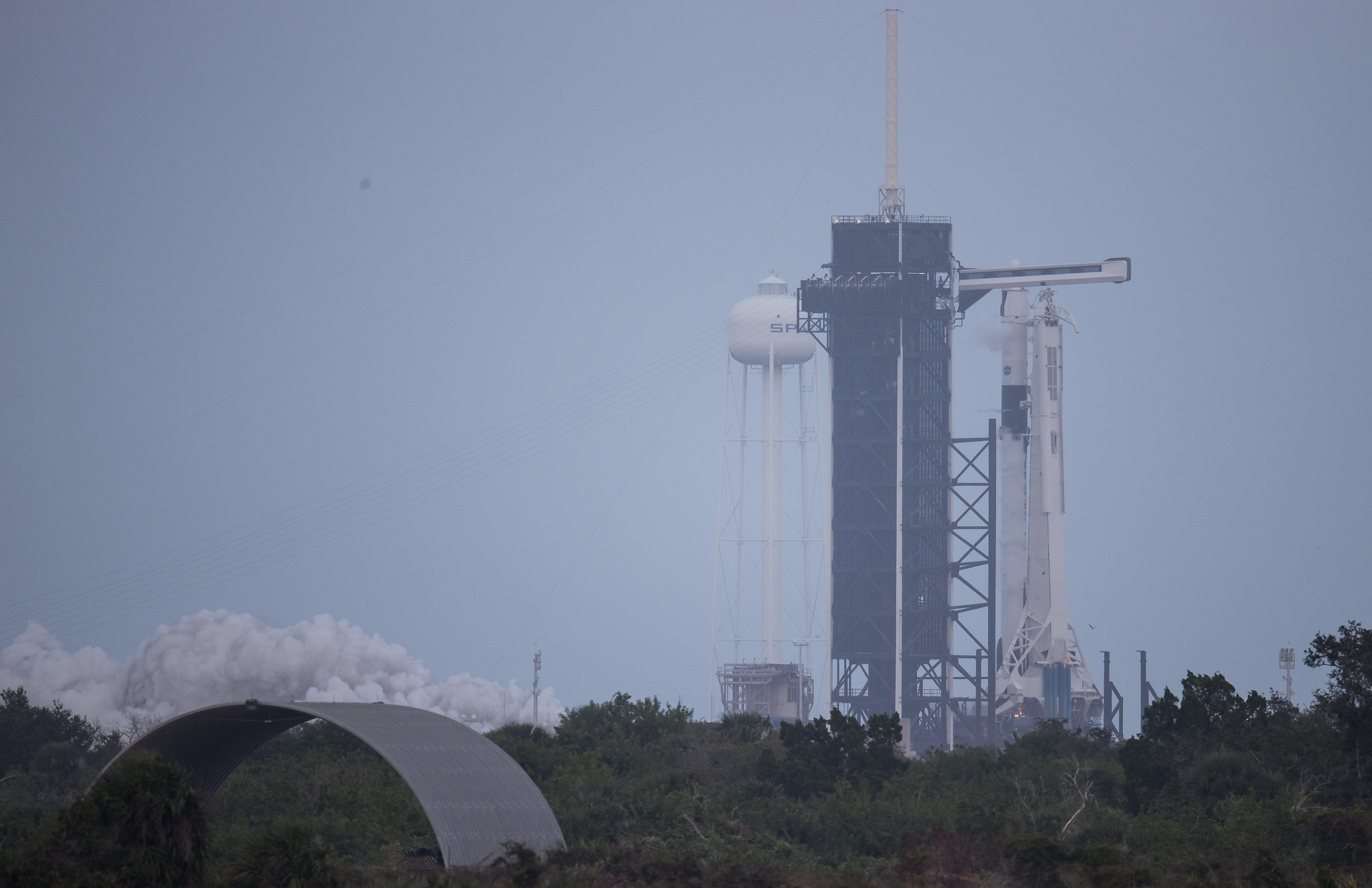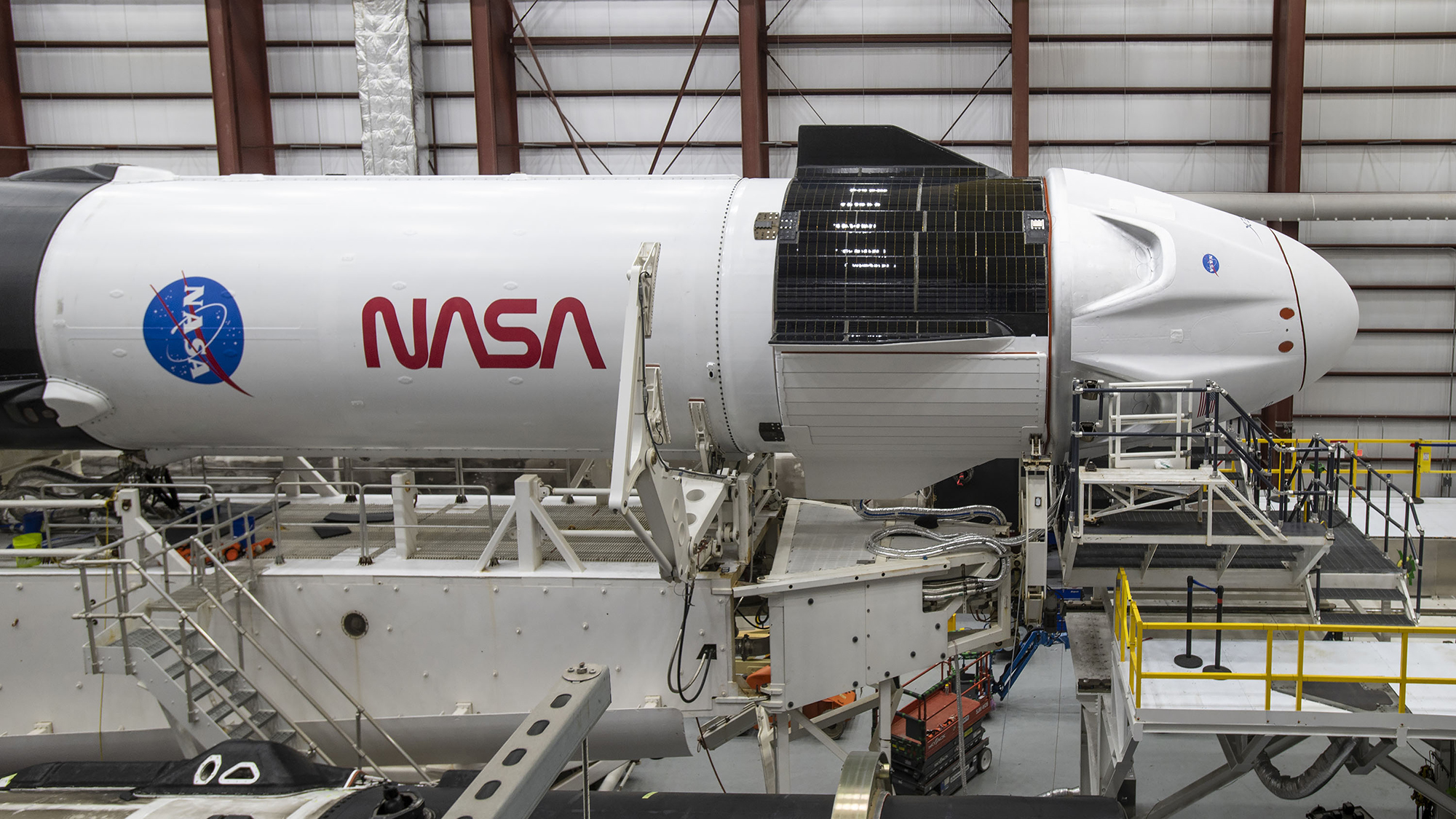SpaceX just test fired the Falcon 9 rocket for its astronaut launch for NASA
CAPE CANAVERAL, Fla. — SpaceX just fired up the rocket that will ferry it's next crew of astronauts to the International Space Station this weekend.
The private spaceflight company conducted a static-fire test on Wednesday (Nov. 11) of its Falcon 9 rocket at Pad 39A here at NASA's Kennedy Space Center. The test is one of the last major milestones ahead of a planned launch on Saturday (Nov. 14).
The routine preflight test kicked off the countdown to the highly-anticipated flight of the company's first operational mission of its Dragon crew capsule, called Crew-1. The spacecraft is bound for the International Space Station, carrying with it three NASA astronauts and one Japanese spaceflyer.
The test, which was originally scheduled for Tuesday evening (Nov. 10), was pushed back 24 hours so SpaceX could test and replace a purge valve in the rocket's second stage.
Live updates: SpaceX's Crew-1 astronaut launch for NASA
In photos: SpaceX's Crew-1 mission to the International Space Station
On Wednesday afternoon, the Falcon 9 rocket roared to life, as smoke billowed from its engines during the preflight test. The brief ignition, known as a static-fire test, is a standard part of prelaunch procedures and one of the last major milestones before liftoff.
During the test, the Falcon 9 is held down on the pad while its nine first-stage engines are briefly fired. This allows crews to ensure that all systems are working properly and that the rocket is ready to fly. Shortly after the test, SpaceX tweeted that the static-fire test was a success and that the company planned to launch on Saturday at 7:49 p.m. EST (0049 GMT on Sunday Nov. 15).
Breaking space news, the latest updates on rocket launches, skywatching events and more!
The flight marks SpaceX's 21st mission of the year and the 1st long-duration mission to launch from Florida. The rocket's first stage is expected to land back at Cape Canaveral Air Force Station approximately 9 minutes after liftoff. If everything goes according to plan, the crew capsule will spend just 8.5-hours trailing the space station before arriving at the orbital outpost early Sunday (Nov. 15).
Both the Dragon capsule and its launcher are brand new for this mission. Following the success of the Demo-2 mission, which launched two NASA astronauts to the space station in May for a two-month stay, NASA has given SpaceX permission to reuse both the crew capsule and the rocket on future missions. In fact, the Crew-2 mission set to launch next year will reuse the Dragon capsule from Demo-2 and the booster from the Crew-1 mission.
Keeping with the precedent set by the Demo-2 mission, the rocket's shiny first stage exterior has been adorned with NASA's iconic worm logo.
With the Dragon capsule perched atop the rocket, the duo rolled out of the hangar and onto the launch pad at complex 39A on Monday evening (Nov. 9). Standing 256.3 feet (78.1 meters) tall, the pair were lifted upright overnight.
Related: SpaceX's Crew Dragon space capsule explained (infographic)
Secured to the launch pad, teams loaded the rocket with super-chilled propellants — kerosene and liquid oxygen — and then briefly ignited the first stage's nine Merlin 1D engines.
The engines briefly fired at 3:52 p.m. EST (2052 GMT), generating 1.7 million pounds of thrust while the booster remained firmly on the ground. Engineers reviewed the data before deciding to proceed with the Falcon 9's planned launch attempt Saturday evening.
"Static fire of Falcon 9 complete — targeting Saturday, November 14 at 7:49 p.m. EST for launch of Crew Dragon's first operational mission to the space station with four astronauts on board," SpaceX tweeted shortly after the test.
The company also said that teams will continue to monitor weather conditions for liftoff and along the flight path closely leading up to launch.
Static fire of Falcon 9 complete – targeting Saturday, November 14 at 7:49 p.m. EST for launch of Crew Dragon’s first operational mission to the @space_station with four astronauts on board. Teams will continue monitoring weather conditions for liftoff and along the flight pathNovember 11, 2020
The static fire test comes on the heels of a hardware swap. Originally slated for Oct. 31, the Crew-1 flight was pushed back two weeks to allow SpaceX time to replace one of the booster's nine Merlin 1D engines on its first stage.
Last month, SpaceX attempted to launch an upgraded GPS satellite when it noticed an engine anomaly. The rocket's on board computer triggered an abort and the mission was indefinitely postponed while teams worked to troubleshoot the issue.
A thorough investigation revealed that residual masking lacquer leftover from the manufacturing process prevented the engines from performing as expected. SpaceX changed out two engines on that rocket and the GPS mission was able to get off the ground on Nov. 5.
SpaceX also took the time to examine two other boosters and determined that the same traces of lacquer were detected in engines on two other Falcon 9 first stages — one on the rocket that will launch the Sentinel-6 Earth-observation satellite and one on the Crew-1 booster. SpaceX then swapped out the affected engines.
With a successful static fire test now under its belt, the rocket is ready to fly. Following the launch on Saturday night, SpaceX plans to land its first-stage booster on one of its two massive drone ships, "Just Read the Instructions," which is stationed out in the Atlantic. If successful, this would mark the 65th booster recovery.
Follow Amy Thompson on Twitter @astrogingersnap. Follow us on Twitter @Spacedotcom or Facebook.

Amy Thompson is a Florida-based space and science journalist, who joined Space.com as a contributing writer in 2015. She's passionate about all things space and is a huge science and science-fiction geek. Star Wars is her favorite fandom, with that sassy little droid, R2D2 being her favorite. She studied science at the University of Florida, earning a degree in microbiology. Her work has also been published in Newsweek, VICE, Smithsonian, and many more. Now she chases rockets, writing about launches, commercial space, space station science, and everything in between.


